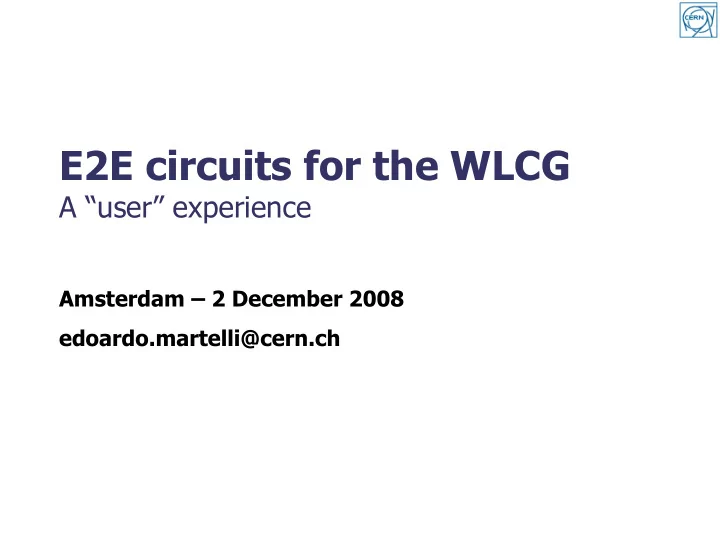

E2E circuits for the WLCG A “user” experience Amsterdam – 2 December 2008 edoardo.martelli@cern.ch
LHC The Large Hadron Collider is a particle accelerator - It collides beams of protons at an energy of 14 TeV - It operates at about – 270 0 C, just above absolute zero of temperature. - It has a circumference of 27km, is located 100mt underground. - It has four major detectors: ALICE, ATLAS, CMS, LHCb CMS LHCb ATLAS ALICE
LHC 3
Data analysis Look for characteristic pattern. Take an event… - 40 million collisions per second - After filtering, 100 collisions of interest per second - A Megabyte of data digitised for each collision = recording rate of 0.1 .. and look for the particle “signature” Gigabytes/sec - 10 10 collisions recorded each year = 10 Petabytes/year of data 4
WLCG: Worldwide LHC Computing Grid Tier-0: The accelerator centre: - data acquisition and initial processing - long-term data storage - distribution of data to the Tier-1 centres Tier-1s: data analysis and distribution - managed mass storage Canada – Triumf (Vancouver) - grid enabled data services France – IN2P3 (Lyon) Spain – PIC (Barcelona) Germany – GRIDKA (Karlsruhe) Taiwan – ASGC (Taipei) - heavy data analysis Italy – CNAF (Bologna) UK – RAL (Didcot) Netherlands – SARA (Amsterdam) US – FNAL (Illinois) Nordic countries – NDGF US – BNL (NY) (distributed) Tier-2s: ~130 centres in 35 countries - end users analysis (where the discovers are made) - simulations 5 5
Circuits to CERN CA-Triumf US-BNL Tier1 TW-ASGC Tier1 Tier1 US-FNAL Tier1 IN-TIFR Tier2 UK-RAL Tier1 FR-IN2P3 CERN RU CERN Tier1 Tier2 Tier1 Tier0 DE-KIT Tier1 CH-UniGE Tier2 IT-CNAF Lambda Tier1 Channel NL-T1 Dark fibre ES-PIC Tier1 NDGF MPLS tunnel Tier1 Tier1 Stitching point 6
Circuits Types Single lambda Multiple stitched lambdas Channel Multiple stitched channels Channel and MPLS tunnel 7
Circuits Requirements Permanent 1Gbps (T2-T1) to 10Gbps (T1-T0) Ethernet 8
Circuits Purchasing More segments (i.e. providers), more paperwork Commercial providers stricter with specifications 9
Circuits Providers Geant2, USLHCnet NRENs Commercial ISPs 10
Circuits Provisioning More segments (i.e. providers), more time NRENs more flexible in fixing stitching problems (optic types, fibre connectors... ) 11
Circuits Utilization Always connected to the external boundaries of the two organizations. All traffic somehow firewalled. BGP routing between the two parts. 12
Circuits Operations So far so good: - Not very difficult to spot a faulty segment - More difficult when issue on the stitching fibre (no man's land) - It helps to have L3 device to insert at the stitching point 13
Conclusion The evil is in the detail 14
Questions?
Recommend
More recommend